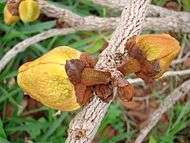Annona crassiflora
| Annona crassiflora | |
|---|---|
| | |
| Scientific classification | |
| Kingdom: | Plantae |
| (unranked): | Angiosperms |
| (unranked): | Magnoliids |
| Order: | Magnoliales |
| Family: | Annonaceae |
| Genus: | Annona |
| Species: | A.crassiflora |
| Binomial name | |
| Annona crassiflora Mart. | |
Annona crassiflora, commonly known as Marolo, Araticum cortiça, Araticum do cerrado or Bruto, is a flowering plant in the Annonaceae family. The flowers of a marolo look like jellyfish wearing hats, and the fruits are sweet and very rough. It is native to Brazil and Paraguay[1] and the fruit is eaten by native peoples in the Brazilian Cerrado.[2] Although it is considered to have potential for cultivation, it has not been domesticated to date.[3]
Description
Marolo is a tree of about 6-8 m tall, with a crown diameter reaching 2-4 m, from the Annonaceae family, which occurs discontinuously in the Brazilian cerrado. The plant prefers the savannah regions with lower moisture deficit such as Minas Gerais, where the fruit is typical and very much appreciated, Mato Grosso do Sul, a small portion of the interior of São Paulo and in isolated parts of Goiás, Mato Grosso, Tocantins, Maranhão and the eastern part of Bahia.
Roots, trunk and leaves

It has axial root system that reaches greater depths in the soil to absorb water and nutrients. Its trunk is straight with crooked twigs, its bark is corky, chipped and thick. It has ovate leaves, leathery, yellow-greenish flowers that occur between November and January, with entomophilous pollination, more specifically by the Ciclocéfalo beetle (Cyclocephala atricapilla). The fruits are multiple bacáceas infructescenses up to 4.5 kg, edible, green-brownish bark when mature, with seeds also regarded as anti-diarrheal.
Fruits

Its fruits reach over 15 cm in diameter and 2 kg, containing many seeds about 1.5 cm long. When opened, the fruit has a creamy pulp and very strong odor and flavor that differs greatly from custard apple. It is considered a delicacy in the Cerrado region, sold in street markets, consumed fresh or as a Cocktail, cake, in the form of cookies, crackers, popsicles, ice cream, jams and many other sweets.
The fruiting begins in November, maturing between February and April, where living in Minas Gerais, where it is popularly associated with the Lent season. When the fruit is ripe it falls to the ground under the protection of the crown, exuding a strong and distinctive smell. These are the best quality fruits for the consumer, because if harvested directly from the tree, the fruit will not mature, producing an inferior quality flavor.
Deforestation and reduction of species
The increasing deforestation of the Cerrado and the delayed germination of seeds, which can reach up to three hundred days, have contributed much to the radical reduction of maroleiros in Minas Gerais. It is the remarkable scientific research work and cultivation developed by João Afonso de Carvalho, professor at the Federal Agrotechnical School in Machado, in southern Minas Gerais, that preserves the Marolo trees region. The locations which concentrate a greater number of species of trees are Carvalhópolis and Paraguaçu.[4]
See also
References
- ↑ Annona crassiflora Mart., GRIN Taxonomy for Plants
- ↑ Roberta Roesler; Luciana G. Malta; Luciana C. Carrasco; Gláucia Pastore (Published Online: 31 May 2006), "Evaluation of the Antioxidant Properties of the Brazilian Cerrado Fruit Annona crassiflora (Araticum)", Journal of Food Science, 71 (2): C102–C107, doi:10.1111/j.1365-2621.2006.tb08882.x Check date values in:
|date=(help) - ↑ Pereira, M. F.; Bandeira, L. F.; Blanco, A. J. V.; Ciampi, A. Y.; Coelho, A. S. G. (2008), "Development of microsatellite markers inAnnona crassifloraMart., a Brazilian Cerrado fruit tree species", Molecular Ecology Resources, 8 (6): 1329, doi:10.1111/j.1755-0998.2008.02275.x, PMID 21586036
- ↑ "Araticum - Annona crassiflora", taodocerrado.eco.br, Tao do Cerrado
External links
-
 Media related to Annona crassiflora at Wikimedia Commons
Media related to Annona crassiflora at Wikimedia Commons